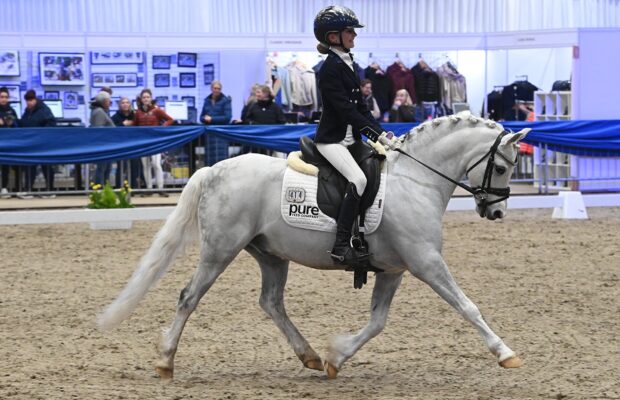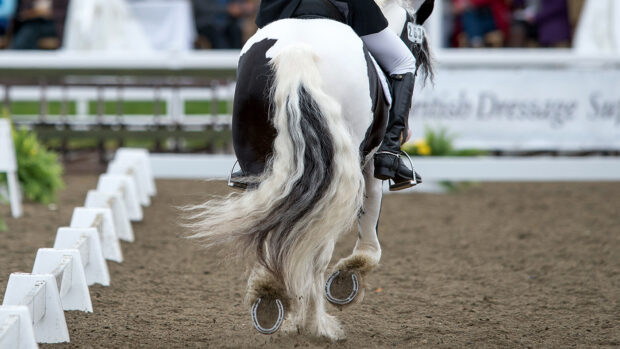Five-star event rider Kate Honey shares her top tips on how to improve your seat in all paces, including canter
Many riders want to know how to sit deep in canter, but I prefer to think of developing an independent seat, which allows the rider to mirror the movement of the horse’s back. The rider needs to use their core strength and seat bones to encourage the horse to come off the forehand and take the weight on to his hind leg to help develop self-carriage.
One way to help a rider develop and engage their core strength is to visualise having a bit of string running through their back to the cantle of the saddle.
When working to develop a deeper seat, be aware that not all horses will tolerate you sitting deep in the saddle for a number of reasons, including not being strong enough in their backs. Which is why I go back to the idea of a secure independent seat with the rider engaging their core muscles so they can deepen or lighten their seat, according to the horse’s needs and level of training.
Should riders aspire to have a deep seat?
While I prefer to think of an independent seat rather than a deep seat, the two often go hand-in-hand. The key is the rider using their core strength to maintain posture and keep in as good a balance as possible with the horse.
This is turn develops a more secure and longer leg and allows the rider to use more subtle seat and leg aids and lessens reliance on the hand.
It also helps the horse to move freely forward from behind and helps in our goal of taking the horse off its forehand and rebalancing him onto the hind leg.
How can I develop a deep or independent seat?
One of the best ways way to help you develop a deep seat is to have a lunge lesson or have someone lunge you. You should ride without stirrups so you cannot balance on your foot. You should also try to avoid gripping or balancing on your knee — you will have to keep yourself in balance using your seat bones and core strength.
I encourage riders to use a number of different exercises to deepen their seat. Stretching down through their toes with a loose leg, doing a pendulum swing from the hip to open up the hip joint and bringing the leg out and away from the saddle and then rolling it forwards and long as you bring your leg back to the horse’s side. Certainly the second two of these exercises need to be done one leg at a time.
I also get riders to ride without reins on the lunge to help them learn not to balance on the rein. Using basic exercises such as hands on head or behind back or windmills with the arms all help promote balance and security. Always ensure that you are using a horse used to someone doing these movements, start in walk and ensure the rider has a neck strap or saddle strap handy for any awkward moments!
Once you have done all of this you should feel yourself sitting deeper and more securely in the saddle. Riders are amazed how much deeper and more secure they feel after a lunge lesson or two.
I’d recommend riders then progress to riding the horse off the lunge in walk and canter without stirrups, before focussing on the trot, which for most people will be the most difficult pace to sit in balance to. A rider will have to sit deep, yet softly, to stay in balance with the horse and not restrict the horse’s movement.
Article continues below…
You might also be interested in:

#SundaySchool: how can I train my horse to be more responsive?
Grand prix dressage rider Alice Peternell explains how to make your horse more forward-going and in front of the leg

How to teach a young horse to turn by following your eyes and body position
We picked five-star event rider Coral Keen’s brains for her to share some of her training exercises for young horses.

Subscribe to Horse & Hound magazine today – and enjoy unlimited website access all year round
Another exercise you can also do on the lunge or when you are riding in the school or out hacking is to practice doing transitions (both from pace to pace and within the pace). So when you want to do a downward transition you sit up tall and push the weight into your lower leg and also your seat. If you want an upward transition you can use your seat as well. As you practice these you will find your horse becomes trained to much more subtle aids, which is why when we look at top riders it all looks so effortless.
Horse & Hound magazine, out every Thursday, is packed with all the latest news and reports, as well as interviews, specials, nostalgia, vet and training advice. Find how you can enjoy the magazine delivered to your door every week, plus options to upgrade to access our H&H Plus online service which brings you breaking news as it happens as well as other benefits.




